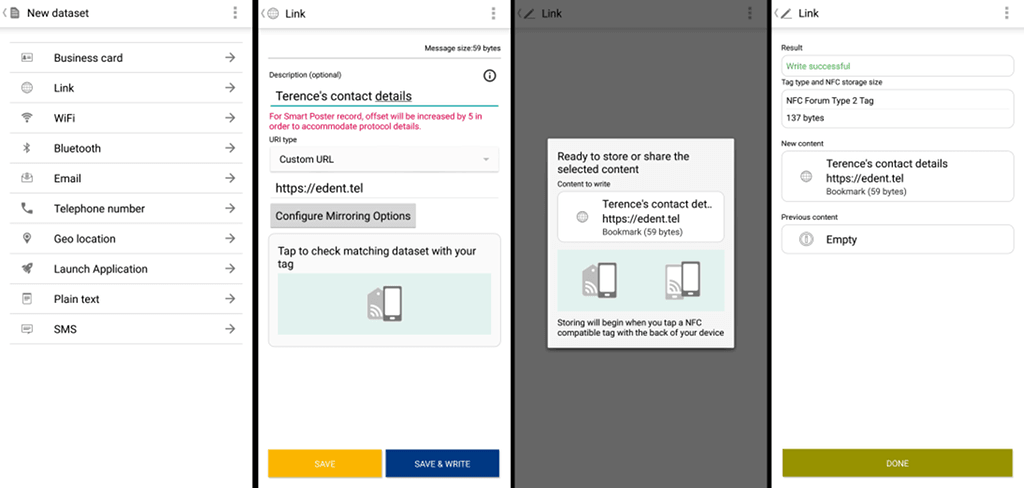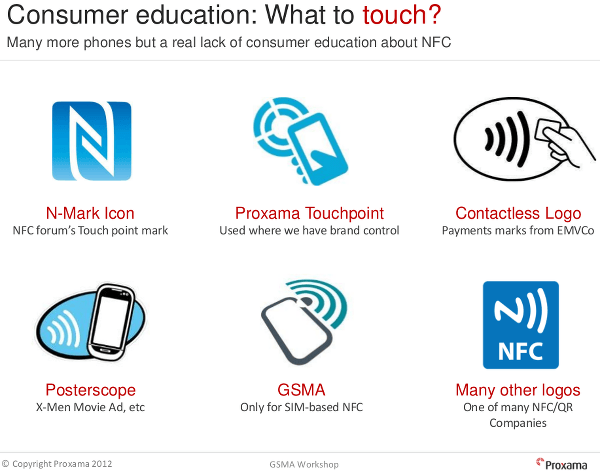Augmenting the human hand - smart nails
My fingers are now Internet-enabled. Well... sort of! My dexterous digits can now wirelessly broadcast URls and all sorts of other information. Here's a video showing how!
My nails contain a URl! pic.twitter.com/MmOvnlqt0u
— Terence Eden is on Mastodon (@edent) January 18, 2019
I have a small NFC chip sandwiched between my finger and a fake nail. NFC - Near Field Communication - is the magic which makes your contactless credit card / Oyster card work. The chip contains a tiny amount of data. When it gets near an electromagnetic source - like a phone - it begins to broadcast the data. When your phone receives the data, it does something with it.
It is important to note, that there is no special app running on my Android phone. Decoding the chip's data is built-in functionality.
The chips cost between £2 - £5 on Amazon - that's a per-nail price. There are bulk discounts available on eBay. You will also need to buy nail glue, polish (if you want a different colour), and removal fluid. The things we do for fashion, eh?
Tech Specs
The chip is made by NXP and is the NTAG213 model. More specifically, the snappily named NT2H1311G0DUx.
According to Adam Nybäck's open source NFC reader, the chip supports the following standards:
- NfcA
- Ndef - NFC Data Exchange Format
- Mifare Ultralight type C
The Ultralight C gives us 106kbps transmission speed - which may seem slow, but the chip is limited to 144 bytes of memory. Better make your URls small! The chip can be written to 10,000 times and has unlimited reads. It uses 3DES for authentication - which I don't fully understand. You can also write protect the chip once you've written data to it.
Finally, each chip also has a 7 byte unique serial number - so you can tell your phone to "do something when you see chip with ID abcd567". For that, you will need a separate app on your phone.
The app
To program the nails, you'll need an app. Jakcom's nail-specific app doesn't appear on the Play Store. Based on the poor reviews for their other app, you're not missing much! You can download it directly - but it asks for ridiculous permissions, so best avoided.

Luckily, NFC is an open protocol - so you can find lots of apps which will write data to the chips.
NXP are the manufacturer of most of the world's NFC tags, their Android app is pretty good. With a couple of taps, you can set the payload and write it to the tag.

Stick 'em on!
If, like me, you're inexperienced with applying fake nails - there's a handy tutorial:
Because you're gluing the chip to the nail, and using acetone to remove it, don't expect these to be reusable. They are relatively fragile - so find a flat bit of your fingernail to stick them to.
The included fake nails were too small for my giant hands - hence why it is stuck to my little finger.
What can it do?
I've set mine to broadcast my contact website.
There are a whole lot more functions, as this video demonstrates:
Security
There is a small security risk with some of the functions. You can tell the phone to call a number, send a text, or an email - but the user has to confirm the action.
Riskier is Bluetooth and WiFi pairing. Long seen on Bluetooth headphones, you can tell a phone to connect to a specific Bluetooth or WiFi device. Again, the user should have to confirm the action - but that will depend on the phone.
Most phones only activate NFC when the screen is on and the device unlocked - so you should be aware that something is interacting with your device.
Different models
The manufactures, Jakcom, have three different models.
- N2F - carries some "information". The phone can then use that to run an app, launch a browser, or similar. That's what I'm using.
- N2L - a light-up chip. Once your finger gets close to a power source, it will light up. Cute!
- N2M - this can, theoretically, hold any data that you can copy from an existing smartcard. So you could embed your work access pass into your thumb. The legality and practicality of this is something I've not explored.
I would love a combined N2F/L chip. I like the idea of my nails flashing multiple colours as that transmit data through the æther.
Usability
Do you know where your phone's NFC sensor is? With a bit of trial and error you can easily find it. But if you want to use your nails to share data with other people's phones, it is a bit more complicated.
You either have to slowly and sensuously stroke the back of the phone until it gives a little jolt of excitement, or laboriously hold your finger over likely spots for a few seconds.
Because the chip is small, and lots of phones have cases which attenuate the signal, placement needs to be quite precise.
Many years ago I wrote about the usability of NFC compared to QR codes - nothing much has changed. At least handing over a business card is more socially acceptable than demanding someone scan my finger.
iPhones
Bloody Apple! They finally have NFC in their latest models, but you need to install an app to read tags. Once done, it is quick.
My NFC finger works on iPhone!
— Terence Eden is on Mastodon (@edent) January 19, 2019
(If you install the NXP tag reader app.) pic.twitter.com/K6Nmcwhbol
There is no way to write a tag using an iPhone.
Raw Info
After scanning the chip with the NXP TagInfo app, this is the technical readout:
-- NDEF ------------------------------
# NFC data set information:
NDEF message containing 1 record
Current message size: 59 bytes
Maximum message size: 142 bytes
NFC data set access: Read & Write
Can be made Read-Only
# Record #1: Smart Poster record:
Type Name Format: NFC Forum well-known type
Short Record
type: "Sp"
# URI record
type: "U"
* protocol field: [none]
* URI field: https://edent.tel
# Text record
type: "T"
* encoding: UTF-8
* lang: "en"
* text: "Terence's contact details"
Payload length: 54 bytes
Payload data:
[00] 91 01 12 55 00 68 74 74 70 73 3A 2F 2F 65 64 65 |...U.https://ede|
[10] 6E 74 2E 74 65 6C 51 01 1C 54 02 65 6E 54 65 72 |nt.telQ..T.enTer|
[20] 65 6E 63 65 27 73 20 63 6F 6E 74 61 63 74 20 64 |ence's contact d|
[30] 65 74 61 69 6C 73 |etails |
# NDEF message:
[00] D1 02 36 53 70 91 01 12 55 00 68 74 74 70 73 3A |..6Sp...U.https:|
[10] 2F 2F 65 64 65 6E 74 2E 74 65 6C 51 01 1C 54 02 |//edent.telQ..T.|
[20] 65 6E 54 65 72 65 6E 63 65 27 73 20 63 6F 6E 74 |enTerence's cont|
[30] 61 63 74 20 64 65 74 61 69 6C 73 |act details |
# NDEF Capability Container (CC):
Mapping version: 1.0
Maximum NDEF data size: 144 bytes
NDEF access: Read & Write
E1 10 12 00 |.... |
-- EXTRA ------------------------------
# Memory size:
144 bytes user memory
* 36 pages, with 4 bytes per page
# IC detailed information:
Full product name: NT2H1311G0DUx
Capacitance: 50 pF
# Version information:
Vendor ID: NXP
Type: NTAG
Subtype: 50 pF
Major version: 1
Minor version: V0
Storage size: 144 bytes
Protocol: ISO/IEC 14443-3
# Configuration information:
ASCII mirror disabled
NFC counter: disabled
No limit on wrong password attempts
Strong load modulation enabled
# Originality check:
Signature verified with NXP public key
-- FULL SCAN ------------------------------
# Technologies supported:
ISO/IEC 14443-3 (Type A) compatible
ISO/IEC 14443-2 (Type A) compatible
# Android technology information:
Tag description:
* TAG: Tech [android.nfc.tech.NfcA, android.nfc.tech.MifareUltralight, android.nfc.tech.Ndef]
* Maximum transceive length: 253 bytes
* Default maximum transceive time-out: 618 ms
# Detailed protocol information:
ID: 04:01:2A:62:F4:48:81
ATQA: 0x4400
SAK: 0x00
# Memory content:
[00] * 04:01:2A A7 (UID0-UID2, BCC0)
[01] * 62:F4:48:81 (UID3-UID6)
[02] . 5F 48 00 00 (BCC1, INT, LOCK0-LOCK1)
[03] . E1:10:12:00 (OTP0-OTP3)
[04] . 03 3B D1 02 |.;..|
[05] . 36 53 70 91 |6Sp.|
[06] . 01 12 55 00 |..U.|
[07] . 68 74 74 70 |http|
[08] . 73 3A 2F 2F |s://|
[09] . 65 64 65 6E |eden|
[0A] . 74 2E 74 65 |t.te|
[0B] . 6C 51 01 1C |lQ..|
[0C] . 54 02 65 6E |T.en|
[0D] . 54 65 72 65 |Tere|
[0E] . 6E 63 65 27 |nce'|
[0F] . 73 20 63 6F |s co|
[10] . 6E 74 61 63 |ntac|
[11] . 74 20 64 65 |t de|
[12] . 74 61 69 6C |tail|
[13] . 73 FE 00 00 |s...|
[14] . 00 00 00 00 |....|
[15] . 00 00 00 00 |....|
[16] . 00 00 00 00 |....|
[17] . 00 00 00 00 |....|
[18] . 00 00 00 00 |....|
[19] . 00 00 00 00 |....|
[1A] . 00 00 00 00 |....|
[1B] . 00 00 00 00 |....|
[1C] . 00 00 00 00 |....|
[1D] . 00 00 00 00 |....|
[1E] . 00 00 00 00 |....|
[1F] . 00 00 00 00 |....|
[20] . 00 00 00 00 |....|
[21] . 00 00 00 00 |....|
[22] . 00 00 00 00 |....|
[23] . 00 00 00 00 |....|
[24] . 00 00 00 00 |....|
[25] . 00 00 00 00 |....|
[26] . 00 00 00 00 |....|
[27] . 00 00 00 00 |....|
[28] . 00 00 00 BD (LOCK2-LOCK4, CHK)
[29] . 04 00 00 FF (CFG, MIRROR, AUTH0)
[2A] . 00 05 -- -- (ACCESS)
[2B] +P FF FF FF FF (PWD0-PWD3)
[2C] +P 00 00 -- -- (PACK0-PACK1)
*:locked & blocked, x:locked,
+:blocked, .:un(b)locked, ?:unknown
r:readable (write-protected),
p:password protected, -:write-only
P:password protected write-only
--------------------------------------
Buy! Consume! Enjoy!
Buy smart fingernails on Amazon. Or don't. I'm not in charge.
Further Reading
New nails for @defcon - 2x MiFare Classic 1K, 2x NTAG 210, 1x NTAG 213, 1x NTAG 215 (as Princess Peach Amiibo), 1x ICODE SL2 ICS20, and 4x NFC LED #DefconNails #DEFCON26 pic.twitter.com/CCmFF7n4z9
— @baybedoll (@Baybe_Doll) August 6, 2018




 Hidden Data in NFC Tags
Hidden Data in NFC Tags
You’re a strange man, Terence. Never change 😊